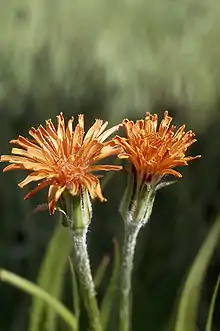| Agoseris aurantiaca | |
|---|---|
 | |
| Agoseris aurantiaca var. aurantiaca | |
| Scientific classification | |
| Kingdom: | Plantae |
| Clade: | Tracheophytes |
| Clade: | Angiosperms |
| Clade: | Eudicots |
| Clade: | Asterids |
| Order: | Asterales |
| Family: | Asteraceae |
| Genus: | Agoseris |
| Species: | A. aurantiaca |
| Binomial name | |
| Agoseris aurantiaca | |
| Synonyms[1] | |
|
Synonymy
| |
Agoseris aurantiaca is a species of plant in the family Asteraceae, commonly called orange agoseris or mountain dandelion. It is widespread in western North America.
Description
Agoseris aurantiaca is a perennial herb or subshrub[2] growing to 60 centimeters (24 inches) in height.[3] It produces a basal rosette of leaves, which are 5–35 cm (2–14 in) long and entire or with irregular tooth-like lobes.[3] There is no stem, but it does produce several stem-like peduncles. Between June and August, each peduncle bears a single flower head 2.5 cm (1 in) in width,[3] surrounded by glabrous to hairy phyllaries. The head is ligulate, containing several ray florets but no disc florets. The florets are most commonly orange but are occasionally yellow, pink, red, or purple. "Aurantiaca" means "orange-red".[4]: 111 The flower head matures into a ball-like head of beaked achenes, each with a terminal pappus of numerous, white bristles.[5]
It is the only orange-flowered species in the genus, the others typically being yellow.[3]
- Agoseris aurantiaca var. aurantiaca – most of species range
- Agoseris aurantiaca var. purpurea (A.Gray) Cronquist – southern Rocky Mountains
Distribution and habitat
The species is widespread and common in western North America from Alaska and the Northwest Territories in Canada southward to California, Arizona, and New Mexico, and eastward as far as the Rocky Mountains and the Black Hills. There are also isolated populations in the Chic-Choc Mountains on the Gaspé Peninsula and in the Otish Mountains of central Quebec.[6][7][5][8][9][10]
It is primarily a species of mountainous regions and may be found in wet to dry habitats.[2]
Uses
A cold infusion of this plant is used by the Ramah Navajo for protection against witches.[11]
References
- 1 2 The Plant List, search for Agoseris aurantiaca
- 1 2 "Lady Bird Johnson Wildflower Center - The University of Texas at Austin". www.wildflower.org. Retrieved 2021-11-28.
- 1 2 3 4 Spellenberg, Richard (2001) [1979]. National Audubon Society Field Guide to North American Wildflowers: Western Region (rev ed.). Knopf. p. 353. ISBN 978-0-375-40233-3.
- ↑ Great Basin Wildflowers, Laird R. Blackwell, 2006, Morris Book Publishing LLC., ISBN 0-7627-3805-7
- 1 2 3 Flora of North America, Agoseris aurantiaca
- ↑ Biota of North America Program 2014 county distribution map
- ↑ Calflora taxon report, University of California, Agoseris aurantiaca (Hook.) E. Greene orange agoseris, orange flowered agoseris
- ↑ Cody, W. J. 1996. Flora of Yukon Territory i–xvii, 1–669. NRC Research Press, Ottawa.
- ↑ Hultén, E. 1968. Flora of Alaska i–xxi, 1–1008. Stanford University Press, Stanford
- ↑ Porsild, A. E. & W. Cody. 1980. Checklist of the Vascular Plants of the Northwest Territories Canada i–viii, 1–607. National Museum of Natural Sciences, Ottawa
- ↑ "Agoseris auranitaca". Herb.umd.umich.edu. Retrieved 2014-03-04.
External links
 Media related to Agoseris aurantiaca at Wikimedia Commons
Media related to Agoseris aurantiaca at Wikimedia Commons- Plants for a Future
- Jepson Manual Treatment
- USDA Plants Profile
- Calphotos Photo gallery, University of California
- Southwest Colorado Wildflowers
- Turner Photographics, Wildflowers of the Pacific Northwest
- Blackfoot Native Plants
